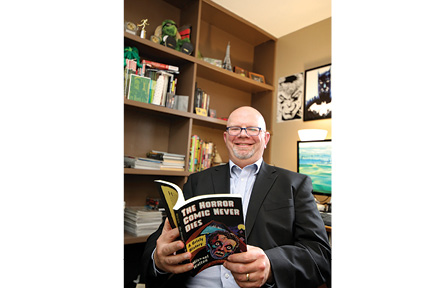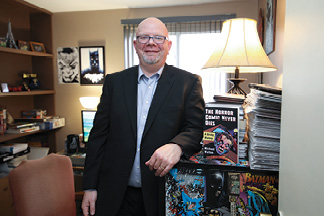Local author ‘seduces’ community with a history of horror comics
by Charles Cassady Jr.
Want to scare horror fans? Don’t mention Jason or Freddy or Michael Myers. Mention Dr. Frederick Wertham.
In the 1950s, the eminent psychiatrist’s book, “Seduction of the Innocent,” theorized that crime, action and horror comics were leading the nation’s youth to juvenile delinquency. Wertham’s allegations actually inspired 1954 Senate hearings that put horror comic book publishers in the hot seat.
Running scared, the comics industry installed a self-censorship “Comics Code” that ended what comics fans call the graphic medium’s Golden Age.
Read the next thrilling installment of what happened next in, “The Horror Comic Never Dies: A Grisly History,” now available from McFarland, a niche publisher of popular-culture volumes. Author Michael Walton has been a Twinsburg resident for 20 years.
“My book focuses primarily on horror comics in the USA, although I do make mention of the inevitable British influence – Neil Gaiman, Grant Morrison, Alan Moore, etc. – on American comics,” said Walton.

Longtime Twinsburg resident Michael Walton pens his first book by exploring how horror comics evolved before and after a landmark self-censorship code that shelved the genre for decades. Photo by K. Garred
This marks the print debut for Walton, who works in information technology but has a longstanding business relationship with the magazines.
“I used to own a comic book store and, obviously, I have collected comics for many years,’’ he said. “As you can probably also imagine, I have a pretty healthy supply of comic books sitting around my house at any given time. My wife is very patient and understanding of my hobby. We met in a comic book store, as a matter of fact.
“Even so, her patience only extends so far. Once the collection of boxes of comic books reaches a certain level, I usually get some gently prompting that it might be time to perhaps demonstrate the fact that those comic books are actually worth the money that I say that they are by selling some off. The time had come for one of these sell-offs, so I booked a table at a small comic convention.”
Walton decided to market the horror-oriented titles from his inventory, to set his stand apart from the superhero genre. “The show was a success, so much so that it sparked the old itch for me to start selling comics again and specializing in just horror comics,” he said.
While interacting with convention-goers, Walton found himself having some of the same discussions about horror comics and their history – “Golden Age, Silver Age, pre-Code, post-Code, horror comic artists, classic titles, etc.”
“I discovered that there was a vast history of a comic book genre that many people weren’t fully aware of,’’ Walton said. “I began compiling all of this information with the original intent of publishing it on my website.”
When the idea grew to book length, Walton submitted proposals to a dozen or so publishers before – to use Stan Lee’s favorite expression – “Excelsior!” McFarland, based out of North Carolina, said yes.
“From the point of my initial idea to the time I delivered my finished manuscript … took a little over two years of work,” the author said.
Like the bloodthirsty vampires, werewolves, curses and zombies they often depict, horror comics are inescapable in any in-depth discussion of panel-narrative storytelling, according to Walton.
“There have been several popular TV shows and movies that have been based on horror comic books,” he said. “Not only that, but many of the comic book industry’s legends got their start doing works on horror comics. This includes Joe Kubert, Jim Steranko, Neal Adams – even Stan Lee and Jack Kirby.”
“Tales from the Crypt,” with its skeletal host the Crypt-Keeper, was a classic horror property that ran from 1950-1955. Its publisher felt compelled to terminate the title and spinoffs because of political and public pressure after “Seduction of the Innocent” (though the stories were much reprinted for nostalgic collectors).
Walton said the real fear that sealed away Crypt-Keeper in cellophane for decades wasn’t rotting ghouls, but kids. Their horror-comics habit made a convenient witch-hunt scapegoat during public hysteria over youngsters misbehaving like James Dean in “Rebel Without a Cause.”
“What surprised me the most in researching this era of American history was how unprepared adults were to handle the concept of a ‘teenager.’ In fact, the word ‘teenager’ itself only started being used in the 1950s,” Walton said. “This was also before America had a juvenile court system, so a juvenile would be treated like an adult and sent to an adult jail, regardless if they were 17 or 11. This was also before the time when police could hand juvenile offenders over to the custody of their parents. This means if you ran away from home and were caught, the police would arrest you and throw you in jail.
“Curfew violation? Jail. Underage drinking? Jail. No wonder juvenile delinquency was such a huge issue.”
Even with the Comics Code in place, publishers like Marvel and DC issued horror/fantasy titles such as “Monsters Unleashed” or “House of Mystery,” albeit with stories far less gruesome than those in the “Tales From the Crypt” period. Sometimes cartoon-sized versions of celebrities like Boris Karloff or Rod Serling served as Crypt-Keeper-style emcees.
Eventually, as publishers became bolder and bolder, the Comics Code faded away. DC Comics was the last major imprint to drop its infamous emblem in 2011.
“Marvel, DC, and Image have always been very superhero-heavy in their offerings with occasional branches into the horror genre, and they have always stayed very PG to PG-13 in their content,” said Walton. “It wasn’t until 2001 when Marvel had withdrawn from the Comics Code Authority that they launched the Marvel MAX line geared at mature audiences with darker storylines and adult language.”
Growing up, Walton apparently had no juvenile delinquency career while absorbing horror comics in small Marion, Va. “I was always a voracious reader, and any trip to my local public library would see me leaving with an armload of books,” he said.
“I read anything I could get my hands on. One of the genres I always gravitated to was horror. I have always loved horror movies and horror novels. Horror comic books were a given for me. I loved the creepy stories and the fantastic artwork.”
Walton and his wife came here as newlyweds, after she accepted a job at Cuyahoga Community College.
“I sold my [comics] store, and we moved to Ohio,” he said. “Neither of us had even been to Ohio before. We knew very little about the Cleveland area and we knew nobody at all who lived here. We lived in Solon for a little over a year before moving to an apartment in Twinsburg. …A short time later, we bought our house in Twinsburg and we have lived here ever since.”
Are there any horror comics that have disturbed Michael Walton? “Some early issues of ‘The Walking Dead’ were the comic equivalent of being punched in the gut,’’ he said. “The showdown with the ‘governor’ at the prison definitely takes a much darker turn in the comic versus the TV show. Garth Ennis wrote a series called ‘Crossed’ for Avatar Press. About three issues in I came to the conclusion that I’m glad I don’t live inside Ennis’ head. This is not a book for the faint of heart.”
Without a Comics Code, what does the now-adult Michael Walton have to say about children reading horror material today? “Dr. Wertham would have a heart attack if he could see some of this stuff!” said Walton about modern horror comics.
What is appropriate?
“Naturally I’m not going to plop some small-press gorefest down in front of a 5-or 6-year-old, but for an early teen, possibly,’’ he said. “Kids are going to push boundaries and read and do things that their parents don’t approve of and that’s all just part of growing up and finding out who you are as a person.
“I mean, honestly, a kid could see much worse content on the news than in a comic book, and at least they could take comfort in the fact that a comic book is not real.”
But “The Horror Comic Never Dies” is very real. It sells on Amazon, and Walton has an author signing scheduled for April 27, from 1-3 p.m. at the collectibles shop R Fun House, 9081 Darrow Rd. in Twinsburg. He will also be attending various conventions and expos, including Retro Invasion Weekend in Westlake at the end of May, and Oddmall at the John S. Knight Center in Akron May 4-5.
As for future literary ventures, Walton said he has never had interest in drawing comics, although writing script-storylines is tantalizing. Future comic-book chronicles he envisions could focus on the changing images of women and minorities in comics.
Added Walton, “I’m in the early stages of a book on comic books as being modern mythology – the age-old tales of gods and heroes with a smattering of cautionary and morality tales thrown in.”
Featured image photo caption: Michael Walton is a fan of all comic genres, but he counts horror among his favorites. On Saturday, April 27, the Twinsburg resident will sign copies of his recently published book, “The Horror Comic Never Dies: A Grisly History,” at R Fun House, located in the former J&B Appliance shop on the northeast side of the Square. Photo by K. Garred

